Ferrari at Indianapolis: mutual love unanswered
Intermezzo: Ferrari and turbocharging
Author
- Henri Greuter
Date
- May 22, 2013
Related articles
- March-Porsche 90P - The last oddball at the Indianapolis Motor Speedway, by Henri Greuter
- March-Alfa Romeo 90CA - Fiasco Italo-Brittanico, by Henri Greuter
- The Race of Two Worlds - The 1958 "Monzanapolis" bash, by Darren Galpin
- Ferrari at Indianapolis, by Henri Greuter
- 1951: Ferrari and Indianapolis
- 1952: Ferrari at Indianapolis
- 1956: A 'hybrid' against one of Indy's most persistent jinxes
- 1958: At home against Indycars
- 1961-1968: of phantoms and enfants terribles
- 1971-1973: 'Meet my uncle Franco'
- 1975: A loud insect never leaving the chrysalis as was intended and hoped for…
- 1986: Projects 034 and 637, mere blackmail tools?
- 2000-2007: It's Indy, Gino, but not as we know it
- Appendix: The cars
Who?Michele Alboreto What?Ferrari 156/85 Where?Zandvoort When?XXXIV Dutch GP (August 25, 1985) |
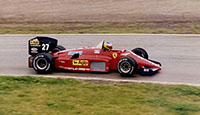 |
Why?
From 1968 on, turbochargers had become near standard on Indycars. So as an intermezzo, here's some more on turbos and what Ferrari had previously done with turbocharging in the years leading towards its next Indycar project in the eighties.
About Turbocharging and Ferrari and turbochargingTurbocharging
Turbocharging as a way to go racing has been described in detail elsewhere, even in this very same series of articles (see 1952, 1968 and 1971-1973), albeit in a different context. Nevertheless, here is a short overview.
Turbocharging is another one of those technologies appearing to be rather modern yet actually known for a long time. The Renault brothers obtained a patent for the principle of turbocharging as early as 1903 but it would take many more years before application became viable. One of the earliest applications was on aircraft engines in the final stages of WWI and thereafter.
One person we must mention with respect to the development of the turbocharger is Major Frank Halford. In 1924 he created a car based on a wrecked Aston Martin and fitted his own engine in it. He experimented with a turbocharger but the blower was deemed unreliable, hence the car never raced with this device. The turbo's glory years were yet to come.
Most likely the first ever racing car with turbocharged engine to make it into a race was the 1952 Cummins Diesel Special. This qualified on pole that year at Indy but had to retire early from the race. This remarkable car pioneered not only the use of the turbocharger, its engine was even more unusual due to being a diesel instead of a petrol-based fuel-consuming engine. On top of that the car also pioneered with serveral novelties in chassis design. It would, however, be a one-off appearance for the turbo.
The turbocharger returned to Indy in 1966 when used on the Offy engine. After a learning period how to tame this engine the first victories soon followed. From there on the turbo became a mandatory part on Indycar engines up until the moment that Indycars got an engine formula that only allowed normally aspirated engines. In previous chapters we already looked at the development of these turbocharged engines.
At about the same time the first experiments with turbocharged engines in Can-Am racing took place but these weren't a success yet.
In the early seventies the turbo reappeared in Can-Am racing, while in European touring car racing BMW began with the 2002 Turbo saloon car. And then in 1974 Porsche introduced the fearsome 911-based Carrera RSR Turbo and put it up against genuine sportscar prototypes. This forerunner of the Group 5 silhouette formula used a 2.14-litre engine which multiplied by 1.4 (the equivalency factor for blown engines) made it equal to a 3-liter engine. Eventually, it worked. From 1976 on, the use of turbocharged engines in sportcars and prototypes increased, Alfa Romeo and Renault the most prominent manufacturers to follow in Porsche's footsteps.
The 1.4 equivalency factor for blown engines running on petrol fuels caused some headaches and developments to make a 2.1-litre turbo the equivalent, power-wise, of a normally aspirated 3-litre engine. Since 1966 Formula One ran under a 3-litre formula as well. The use of blown engines in F1 was permitted but not quite encouraged due to the application of an equivalency factor of 2. It was only in 1975 that Renault took up the challenge and started the project which had to result into the construction of a turbocharged 1.5-litre F1 car. After several tests with such an engine a Renault F1 car debuted in the British Grand Prix, in the summer of 1977. The care made several appearances after that but didn't cause too many worries among the primarily British-based, Cosworth DFV-using F1 teams.
Renault did the full 1978 season with a single car, driven by Jean-Pierre Jabouiile but only at the end of the season at Watkins Glen did he finish within the top-six to score the first-ever points for a turbocharged F1 engine, but there had been more signs of long-term potential of a turbocharged F1 engine. Some other teams began to take notice.
One year later, in 1979, Renault fielded two drivers all season long: Jean-Pierre Jabouille and Rene Arnoux. Jabouiile scored Renault’s first pole position at Kyalami, an achievement many credited to the high altitude of the track which worked into the advantage of the turbo.
The second half of the season saw the first victory for Renault, courtesy of Jabouille at (how sweet can it be) Dijon-Prenois, thus 'at home' in France. Some other competitive outings followed but reliability was still a problem. But by now, the British kit-car constructors no longer laughed about the turbo. Instead, they began complaining about its unfair advantage. The factory support such projects needed was another factor involved in these complaints.
Jabouille and Arnoux continued into 1980 and Arnoux won two of the first three races of the season. That was however the highwater mark for him and to some extend Renault. Jabouille won a single race in the Summer but Renault could not put up a serious title challenge that season. Still, they were more competitive that season then the title defenders: Jody Scheckter and Ferrari.
With hindsight one could say that Ferrari had a dream season in 1979 because it was the one team that remained competitive all season long. Ligier appeared to run away with the season by winning the first two races of the year and also winning the fifth race. But from then on the French team simply lost it. During the second half of the season the Williams FW07 was the car to beat but that was too late to win the titles. And thus Ferrari managed to win both titles. The most stable team all season long with what often was the second best car in the race, but one that was bulletproof, had taken the prizes. The following year, however, proved how lucky Ferrari had been in 1979.
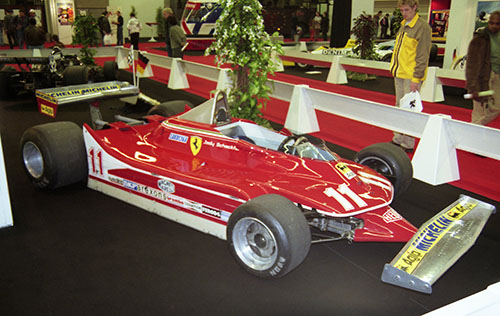
Seen at a car show in the Netherlands in November 1995: a Ferrari 312T4, the car that made Ferrari and Jody Scheckter the F1 World Champions of 1979. This is chassis 038. (photo HG)
In 1977 Lotus had introduced ground effect, a technology in which the floor of the car was used to generate downforce, thus enhancing grip in the corners and increasing cornering speeds. A year later, Lotus had improved on this concept even further and the Lotus 79 was the class of the field, giving Mario Andretti a relatively easy time of winning the title. In 1979 almost everyone in F1 used ground effect, with the notable exception of Ferrari.
In the 1971-1973 chapter we already mentioned that Ferrari in F1 at that time used a flat-12 3-litre engine. It had remained in use ever since, and with stunning success since 1974. With the exception of 1978, Ferrari had been a contender for the titles every season since 1974, indeed winning the constructor titles in '75, '76, '77 and '79 and taking the driver's titles in these years too, except for 1976. But in 1979 the flat-12 got its death knell too. Ground-effect chassis were the way to go and the flat-12 was too wide to permit decent ground-effect tunnels. The 1979 312T4 was a semi-ground effect car at best which could put up some kind of a challenge against the opposition that had yet to fully sort out their ground-effect cars. The successor to the T4, the T5, stood no chance against its opposition. The flat-12 which had served Ferrari so well in the past decade wasn't obsolete as such but had simply become unsuitable.
Alfa Romeo, also using a flat-12, was in a similar position. In a short period of time they managed to create a V12. Ferrari, on the other hand, solved the problem in a different way.
Ferrari and turbocharging
At Maranello, they had recognized the potential of the turbocharged engine. And if the flat-12 had to be replaced with a new, V-type engine, then why not attack the future with the technology of the future?
The first work on this project was undertaken as early as 1979. In a Dutch magazine I found reference to a turbocharged Ferrari being tested late 1979 (October 24-25) at Paul Ricard. Translated from Dutch it reads: "Besides Lotus, Ferrari carried out a testing programme with the new, 6-cylinder V turbo, based on the Dino engine. For the time being the engine is built into last year's car. Gilles Villeneuve is driving the car."
While Jody Scheckter and Villeneuve fought a lost cause in the 1980 GP season the work on the new car continued. In the closing stages of the season that drove Ferrari fans into desperation because of the appalling results, the home crowd at Imola got to see what Ferrari had in store for the future. Villeneuve was permitted to practice with the turbo prototype on the Saturday of the GP weekend at Imola. Though he qualified 8th fastest with the car he raced a 312T5 and had a monumental crash in it.
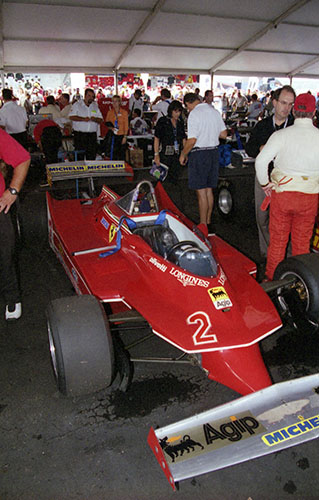
According to the chassis plate at least, this is the actual 312T5 which Villeneuve raced and crashed at Imola in 1980: 312T5 chassis 048, pictured here in the historic F1 paddock at the inaugural Indy GP in September 2000. (photo HG)
The turbo Ferrari engine was named 126C and was a V6 with a block angle of 120 degrees. Interestingly enough, the team had used such a construction as well in the early 60s.
Early 1981, after a number of political issues being settled at last, the Ferrari turbo debuted during the Long Beach GP. In practice the cars had used a Comprex supercharger (the only time this type of blower was seen in the GP weekends) but the cars raced with conventional turbos.
The debut race of the 126CK has been described as splendid since both cars ran consistently in the top-five until they had to be retired. The first three races of the season all ended in double retirements. In the fourth race of the season Gilles Villeneuve was fastest in qualifying and scored the turbo car's first ever pole. The race itself was a rain-affected affair in which Gilles got fooled up in tyre stops. His seventh place caused thoughts about what could have been. Fortunately, team mate Didier Pironi got home fifth, scoring the first points for the turbo Ferrari. The first performance on home ground (the race in question had been at Imola) had been sweet after all.
Three races later, the Ferrari fans worldwide had reasons to anticipate a fantastic season coming up for their beloved team. Belgium, the fifth race of the season, saw yet another points-scoring finish (Villeneuve taking fourth) and to sheer amazement of just about everyone Gilles Villeneuve won the two next races on what were definitely turbo-unfriendly tracks: Monaco and Jarama.
At Monaco Keith Duckworth said to Patrick Head that if Ferrari would ever build a decent chassis only the Good Lord could help the other teams. It was an acknowledgement of the situation. The Ferrari V6 engine had presented itself as one of the best engines in the field but installed in one of the poorest chassis of the field. However, all hopes that had grown during spring for a great second half of the season were unfulfilled. In just one more race the 126CK (perhaps more correct: one of its drivers) starred. In turbo-unfriendly conditions once again (pooring rain in Canada) Villeneuve took third place after an eventful race in which he finished without a front wing.
Ferrari's first year with turbocharged engines in F1 thus ended somewhat peculiar. No doubt that the engine department had done a magnificent job but it had been let down by the chassis department. The car scoring its most impressive results on tracks and in conditions that on paper didn't suit it said it all.
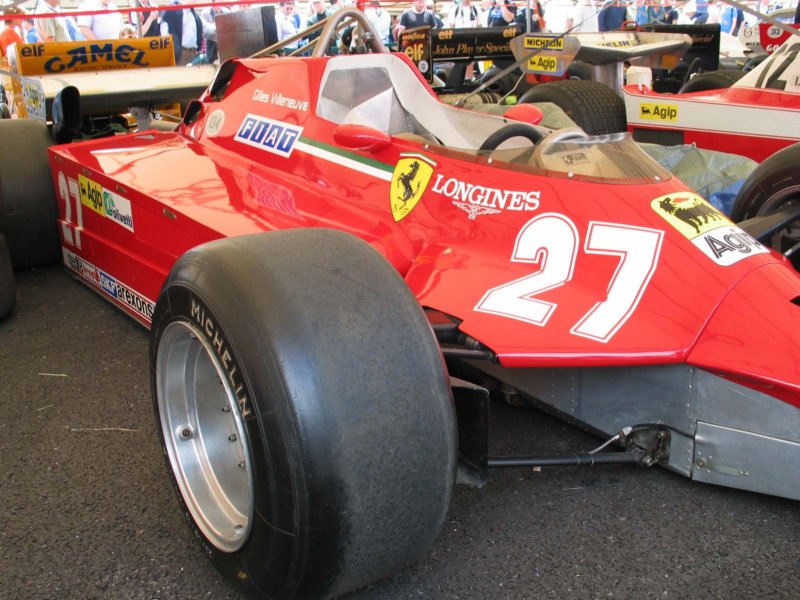
Villeneuve's Ferrari 126CK as seen at the 2004 Festival of Speed at Goodwood. (photo 8W)
Ferrari already acknowledged the problem during 1981 by hiring British chassis designer Harvey Postlethwaite. It showed off the following year. The 1982 car, named 126C2, was a much more competitive tool all season long but its reputation as a decent car was forever tarnished after it became involved in horrific crashes that were fatal in one case (Villeneuve) and career-ending in the other (Pironi). Pironi was leading the title chase at the time of his near fatal accident. His chances of winning the driver's title looked very good if he and Ferrari would have kept the momentum they had maintained since the Dutch Grand Prix.
Still, despite being used by four different drivers that year, the 126C2 had been competitive and reliable enough to enable all drivers combined to score enough points for the constructors title, making Ferrari the first team to win one of the championships using a turbocharged car. Even more impressive, and telling a lot about the kind of season 1982 was for other teams as well, Ferrari won the title despite non-starting in two events and racing a single car in six events. So its title was based on only 22 out of a possible maximum of 32 starts. Pironi was still classified second in the drivers championship, despite only starting ten times. The key to Ferrari's title was reliability. Out of those 22 starts there were only four retirements. The remaining 18 classifications saw 14 points-scoring positions. Nowadays, with reliability rates of 90% and more, Ferrari's 1982 figures are laughable but at the time, in only the second year of duty for the 126C turbo engine, Ferrari's achievement in that tragic year was remarkable indeed.
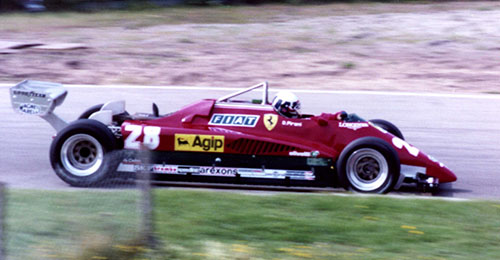
Zandvoort 1982: eventual race winner Didier Pironi in an example of the Ferrari of mixed emotions: 126C2. (photo Guido de Jong)
The constructors title was defended successfully in 1983 but both Patrick Tambay and René Arnoux were unable to remain competitive all season long, enabling neither of the two to clinch the drivers title. Interestingly enough, Ferrari used a "B" version of the 126C2 in the first half of the season while in the second half the team fielded the new 126C3. This policy was partly related to the massive rule changes introduced for the 1983 season, responding to the tragic events of the season before. Many teams were forced to start all over again by designing new flat-bottom cars from scratch.
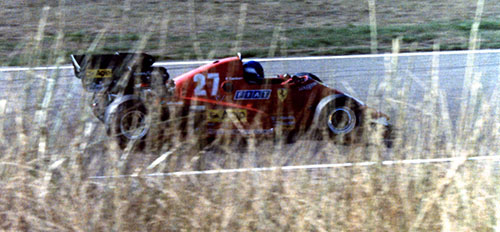
"Wat ráást er langs het struikgewas?" Dutch readers may understand the practical joke in this expression. Patrick Tambay rushing along the wildlife at Zandvoort in his 1983 126C3. (photo HG)
Nevertheless, Ferrari's first three years using turbocharged F1 engines had yielded more results for them in comparison to what turbo pioneer Renault had achieved.
From 1984 on, however, Ferrari went into slow decline. There would be a ban on refuelling in 1984, as well as a maximum fuel tank capacity of 220 litres. This was the first attempt to restrict engine outputs in at least race trim. In qualifying no limits were applied, which started a trend of qualifying engines far more powerful than the race-day versions of the same engine.
With respect to the factors contributing to the slow decline of Ferrari: besides the introduction of fuel consumption limits for the race, 1984 saw the arrival of two engines that were to dominate the F1 in the years to come. The Porsche designed and built TAG V6 and the Honda V6 were a few years younger in design and it became ever more difficult for Ferrari to make the by now ageing 126C engine keeping up with these opponents. In 1984 no-one could do anything against the McLaren-TAGs in the races.
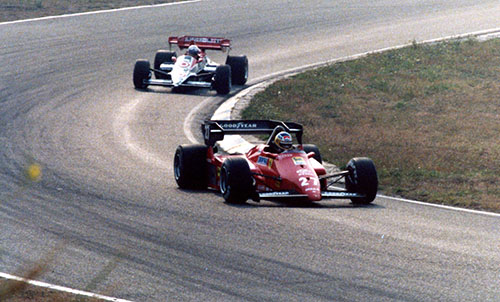
At best the second best car in 1984 but often third best, and miles and miles behind the unbeatable McLaren-TAGs: the 126C4. (photo HG)
One year later, Ferrari fielded the 156/85 which differed from the previous turbo Ferraris because of having followed the trend of installing the turbos next to the engine in the sidepods instead of on top of the engine within the V. After a decent first half of the season driver Michele Alboreto was still a contender for the title as late as mid August.
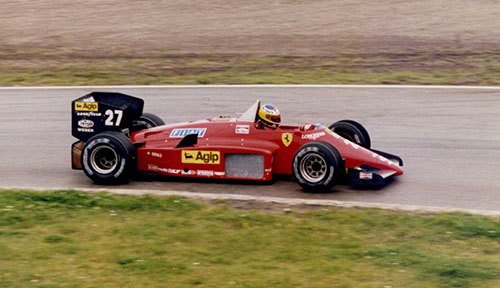
Zandvoort was the last race of the 1985 season in which Michele Alboreto appeared to be still within a chance of winning the title in case the recent performance decline had only turned out to be a minor dip. Purists will know that this is a picture taken during practice since on race day the vertical sidefins of the diffuser below the rear wing had been cut off in a desperate attempt to improve the car's handling. (photo HG)
But Ferrari pretty much collapsed in the final part of the season, a collapse that would go on into the 1986 season.
If it was down to the application of turbochargers, at least in F1 Ferrari had shown to be quick learners capable of producing a competitive package in a short space of time. In 1986, the real turbo successes had by then been some time ago but the organisation still had potential to spare, even though some sort of rejuvenation was needed to extract the most out of the organisation. Such had happened before, and with decent results: history had repeated itself on earlier occasions and could do so again.
In another aspect, however, the turbocharged F1 Ferraris failed miserably, in contrast to the turbocharged F1 cars of some of their opponents.
In the early 80s, also because of the application of the turbo in racing, more car companies included turbo models for a sportier image or, in the case of Renault, to create a direct link with their F1 participation. That 'turbo wave' disappeared after the change to atmo engines in 1989. After that, turbos were still used in production cars but with much less attention to the application of the device.
Given the sporty or even racy image of the turbo, and also given the fact that Scuderia Ferrari was the first to follow Renault in using turbocharged F1 engines, one would assume that turbos would be used in Ferrari production cars as well. This did indeed happen but to a rather limited extent and for a very short amount of time.
Due to tax regulations in Italy favouring cars with under-2-litre engines, Ferrari had produced a 2-litre version of its V8 engine and fitted this into the 308 bodyshell, creating the 208GTB and GTS. These cars weren't living up to the Ferrari standards. In 1982, however, the success of the turbo F1 cars inspired Ferrari to produce a turbocharged version of this 2-litre engine that still had a tax advantage but performance-wise came much closer to the bigger 308s. According to factory records, 437 of these 208GTB Turbo cars were built until 1985, and 250 of the GTS (Spyder version).
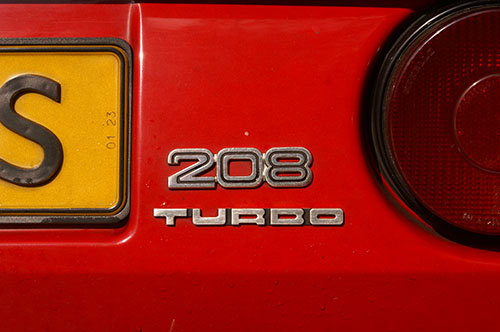
From a distance it takes a good look to identify a 208GTB Turbo because it looks near similar to a 308. If you come close enough to the name plate, however, there is definitely no mistake in recognizing a type of Ferrari that is even more of a rarity that the fabled F40. (photo HG)
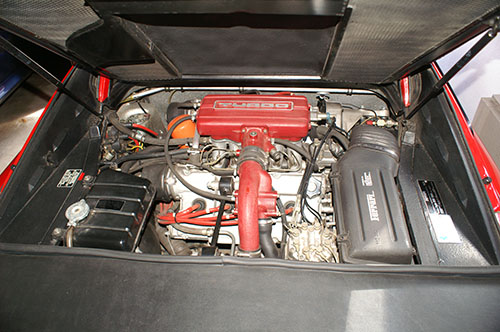
This it how it looks beneath the engine cover of the 208 Turbo. The actual turbo isn't visible since it's on the back side of the engine. (photo HG)
Ferrari's next 'production car' with a turbocharged engine was introduced in 1984, also inspired on the 308 bodyshape and simply named GTO. Unofficially it is referred to as 288GTO as well. It had a 2.8-litre version of the V8 fitted with two turbos and it was one of the first of the so-called supercars. There were some thoughts of using the car in competition, and to allow that it was necessary to build at least 200 examples in order to obtain homologation. This duly happened: the records mention that 272 cars were built. The thoughts of racing it, however, never materialized.
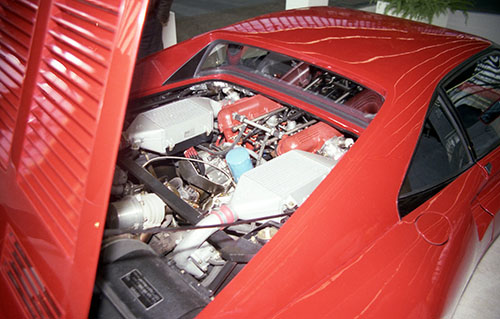
Unlike the 208GTB Turbo which had its engine installed transversally, the GTO's engine was installed longitudinally. This picture was taken on the Amsterdam RAI car show in 1985. A GTO that was already sold was allowed to steal the show on the Ferrari stand. (photo HG)
A new 'low-tax special' was introduced in 1986 with the GTB Turbo, which was essentially the 328GTB but fitted with the 208Turbo engine. Until 1989 the company made 308 (what's in a number!) of such cars. The GTS version was also offered for sale. 828 of such cars have been built.
In 1987, Ferrari announced the car with which it celebrated its 40th anniversary, the F40. It was the wildest variation with roots that could be traced back to the 308 bodyshape. Curiously enough, this genuine 'supercar' is one of the least rare in the category since Ferrari built no less than 1131 of them, the last ones as late as 1992.
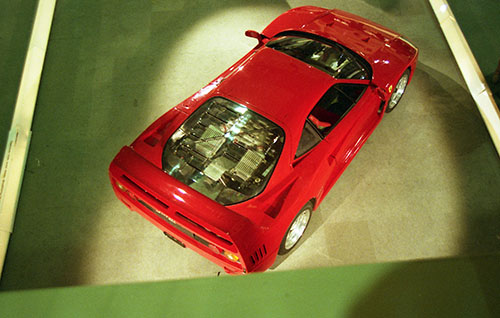
To show that it is possible to picture an F40 without putting the focus on its massive rear wing, you need an unusual position like the one I tried to see more of the engine. But I admit, this doesn't make the F40 look as spectacular as it really is. (photo HG)
We will have to wait for the next production Ferrari fitted with a turbocharged engine, since apart from the two-litre 'low-tax specials' and the two supercars Ferrari has put its faith in ever larger normally aspirated V8s (up to 4.5-litre in 2013) and of course its most beloved engine configuration of all: the V12.
For whatever reason turbocharging never made it big in the Ferrari production line, despite (or because) of the successes (or lack of) of their turbocharged racing cousins.
